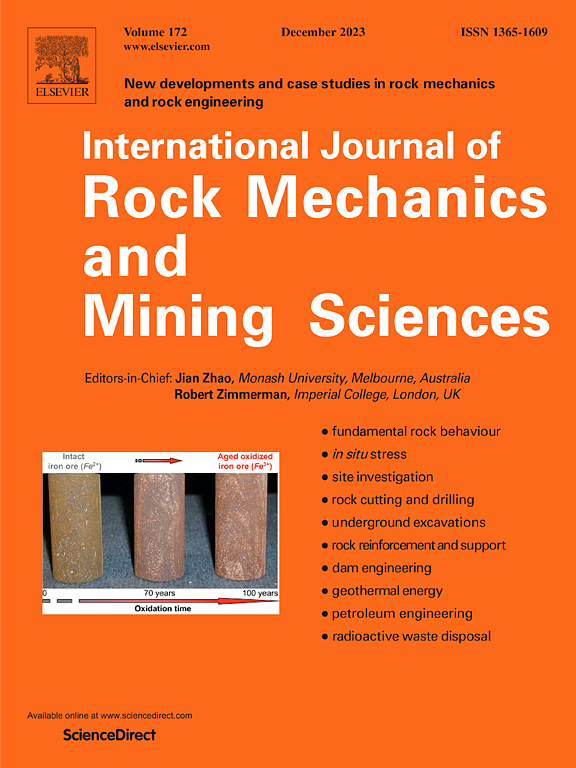Microcrack evolution and local stress inversion at the bottom of a high arch dam during operations across a major earthquake based on microseismic monitoring
IF 7
1区 工程技术
Q1 ENGINEERING, GEOLOGICAL
International Journal of Rock Mechanics and Mining Sciences
Pub Date : 2025-03-11
DOI:10.1016/j.ijrmms.2025.106089
引用次数: 0
Abstract
High arch dam is susceptible to microcracking at its bottom due to stress concentration. Therefore, it is crucial to investigate microcracking at the dam bottom for evaluating the integrity and safety of the high arch dam during its operation. In this study, based on the microseismic (MS) data monitored at the bottom of the Dagangshan high arch dam during its normal operation across the Luding Ms6.8 earthquake, the moment tensor inversion and iterative joint inversion methods were implemented to analyze the focal mechanism of microcracks. This analysis revealed the evolution characteristics and fracture types of microcracks as well as explored the stress characteristics at the dam bottom. The results indicated that the MS events at the dam bottom were mainly distributed from the dam heel to the middle of the dam bottom. The fracture types were primarily compressive and tensile, which occupied approximately 38 % and 32 %, respectively, in average, and the microcracks form fracture channels in the NW-SE and NE-SW directions. The stress inversion analysis clarified that the occurrence of the microcracks at the dam bottom were primarily controlled by compressive stress, with the maximum principal tensile stress being dominant in the SW-NE directions. The primary stress axis of the stress field at the dam bottom exhibited minimal variations before and after the earthquake, suggesting that the bottom of the Dagangshan high arch dam remained stable after the earthquake. However, the earthquake and its aftershocks altered the opening and closing states of the microcracks, which was the main reason for the sudden change in seepage pressure at the dam bottom. Therefore, this study helps to reveal the damage mechanism and local stress characteristics of the high arch dam, and provides a reference for seepage control and removal, as well as safety and stability evaluation of the high arch dam.
基于微震监测的高拱坝跨强震运行过程底部微裂缝演化及局部应力反演
高拱坝由于应力集中,坝底易发生微裂缝。因此,研究坝底微裂缝对评价高拱坝运行过程中的整体性和安全性具有重要意义。本研究基于大岗山高拱坝在泸定6.8级地震正常运行期间的坝底微震监测数据,采用矩张量反演和迭代联合反演方法分析微裂缝的震源机制。分析揭示了坝底微裂缝的演化特征和断裂类型,探讨了坝底应力特征。结果表明,坝底MS事件主要分布在坝后跟至坝底中部。裂缝类型以压缩裂缝和拉伸裂缝为主,分别约占38%和32%,微裂缝在NW-SE和NE-SW方向形成裂缝通道。应力反演分析表明,坝底微裂缝的发生主要受压应力控制,最大主拉应力在西南向—东北向主导。坝底应力场主应力轴在地震前后变化最小,表明大岗山高拱坝坝底在地震后保持稳定。然而,地震及其余震改变了微裂缝的开闭状态,这是坝底渗流压力突变的主要原因。因此,本研究有助于揭示高拱坝的破坏机理和局部应力特征,为高拱坝的防渗排渗及安全稳定性评价提供参考。
本文章由计算机程序翻译,如有差异,请以英文原文为准。
求助全文
约1分钟内获得全文
求助全文
来源期刊
CiteScore
14.00
自引率
5.60%
发文量
196
审稿时长
18 weeks
期刊介绍:
The International Journal of Rock Mechanics and Mining Sciences focuses on original research, new developments, site measurements, and case studies within the fields of rock mechanics and rock engineering. Serving as an international platform, it showcases high-quality papers addressing rock mechanics and the application of its principles and techniques in mining and civil engineering projects situated on or within rock masses. These projects encompass a wide range, including slopes, open-pit mines, quarries, shafts, tunnels, caverns, underground mines, metro systems, dams, hydro-electric stations, geothermal energy, petroleum engineering, and radioactive waste disposal. The journal welcomes submissions on various topics, with particular interest in theoretical advancements, analytical and numerical methods, rock testing, site investigation, and case studies.

 求助内容:
求助内容: 应助结果提醒方式:
应助结果提醒方式:


